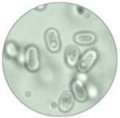Genome-scale model of cyanobacterium developed

(Phys.org) -- In an important step toward engineering bacteria to produce biofuel, scientists have developed one of the first global models for the nitrogen-fixing photosynthetic cyanobacterium Cyanothece sp. ATCC 51142 (see sidebar).
This genome-scale metabolic reconstruction and simulation model describes the cyanobacterium's complete metabolism and not just isolated pathways, according to the scientists.
"The model details how carbon and energy are distributed throughout the cell for photosynthesis and respiration," said Pacific Northwest National Laboratory microbiologist Dr. Alex Beliaev. "It will serve both as a platform to develop similar models for other cyanobacteria and as an engineering tool for manipulating photosynthetic microorganisms to improve biofuel production."
PNNL scientists and collaborators at University of Wisconsin-Madison, and Burnham Institute for Medical Research coauthored the research paper, which appears in the April 5 issue of PLoS Computational Biology.
Cyanobacteria are potential platforms for biofuel production because they photosynthesize, have relatively rapid growth rates and tolerance to extreme environments, and can accumulate high amounts of intracellular compounds. But only a few models have been developed for investigating them because they are so complex.
Beliaev added, "Developing a computational model brings us closer to a systems-level understanding of the metabolism of photoautrophs such as Cyanothece, putting metabolic engineering of these organisms within reach."
Using combined computational and experimental approaches, the scientists investigated the interplay of photosynthetic and respiratory fluxes. They modeled photon fluxes and electron flux distributions under conditions of variable light quality and intensity, and analyzed the contribution of different electron transfer pathways to growth.
They used a novel custom-built photobioreactor at PNNL to test the predicted changes in growth rates of Cyanothece 51142 in response to changes in light input. The reactor instrument couples on-line gas monitoring and feedback-controlled lighting to obtain high-resolution physiological details of the relationship between photosynthetic O2 evolution and H2 production in Cyanothece 51142. See: Figure 3. Model predictions of Cyanothece 51142 growth rate and electron transport pathways at different photon uptake rates through PS II and PS I.
The team will apply the model to conduct a quantitative analysis of light-driven hydrogen production and identify ways to improve the efficiency of the process. The researchers hope to use data from actual enzymatic activities as additional factors for determining whether to consider fluxes through associated reactions.
More information: Vu TT, et al. 2012. "Genome-scale modeling of light-driven reductant partitioning and carbon fluxes in diazotrophic unicellular cyanobacterium Cyanothece sp. ATCC 51142."PLoS Computational Biology 8(4): e1002460. doi:10.1371/journal.pcbi.1002460
Journal information: PLoS Computational Biology
Provided by Pacific Northwest National Laboratory




















